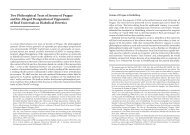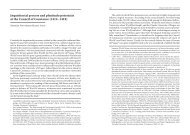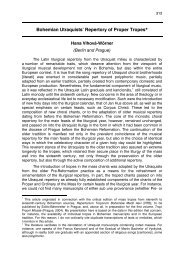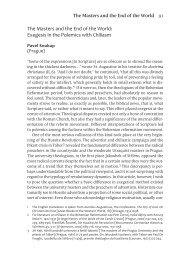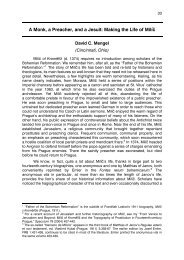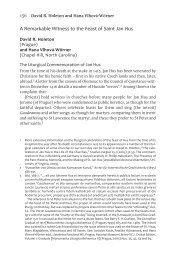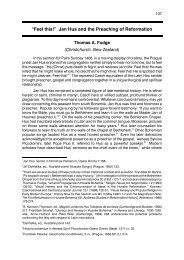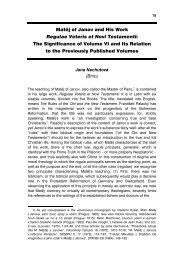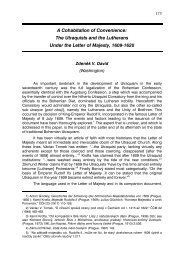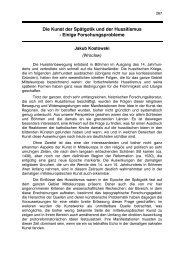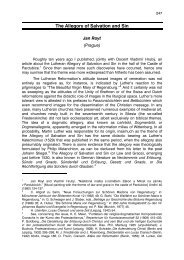quod mulieres, que sunt in Christo, in hoc - Bohemian Reformation ...
quod mulieres, que sunt in Christo, in hoc - Bohemian Reformation ...
quod mulieres, que sunt in Christo, in hoc - Bohemian Reformation ...
You also want an ePaper? Increase the reach of your titles
YUMPU automatically turns print PDFs into web optimized ePapers that Google loves.
82<br />
“Matěj of Janov <strong>in</strong> his work Regulae Veteris et Novi Testamenti for the first time<br />
expressively captured the images of the new, more <strong>in</strong>tense and earnest Czech<br />
women who cooperated with their male counterparts <strong>in</strong> pav<strong>in</strong>g the road towards a<br />
<strong>Bohemian</strong> religious progress.” 5 The church reform began, accord<strong>in</strong>g to Janov, about<br />
fifty years earlier, and gathered strength from of the preachers’ sermons, and the<br />
more <strong>in</strong>tense work<strong>in</strong>gs of Christ’s spirit. Among the tell<strong>in</strong>g signs he listed the laity’s<br />
yearn<strong>in</strong>g for fre<strong>que</strong>nt communion, the revival of the spirit of humility and the flam<strong>in</strong>g<br />
love for the crucified Christ, as well as the great piety of women. 6 Referr<strong>in</strong>g to the<br />
latter, Janov stated explicitly: “I say these are the women who live accord<strong>in</strong>g to Jesus<br />
Christ and greatly excel men <strong>in</strong> the matters of faith, hope, mercy, prayer, penance,<br />
cont<strong>in</strong>ence, purity, humility, and the cultivation of specific virtues....” 7 Janov’s<br />
account dovetailed with the stories about the reform of proud and va<strong>in</strong> women, who<br />
had responded to the admonitions of Waldhauser and Milíč, and demonstrated their<br />
<strong>in</strong>ner change from the vice of pride to the virtue of humility by putt<strong>in</strong>g away the<br />
precious garments and jewels. 8<br />
Janov’s view of contemporary fem<strong>in</strong><strong>in</strong>e piety harmonized with his theological<br />
<strong>in</strong>terpretation of history. Accord<strong>in</strong>g to him, the effervescence of female piety resulted<br />
from a downward trend <strong>in</strong> the status of males who – although <strong>in</strong>itially outstand<strong>in</strong>g<br />
and superior <strong>in</strong> their power of spirit – currently became enfeebled <strong>in</strong> their thoughts,<br />
and collectively turned to the vanities and splendors of this world. As the crucified<br />
Christ once <strong>in</strong> va<strong>in</strong> had sought help among the males, so also currently he would<br />
have hardly found a place where to lay his head, <strong>in</strong>asmuch as men – one and all –<br />
had looked away and become unhelpful. Christ, therefore, turned deservedly and<br />
appropriately to the weak female gender, which was held <strong>in</strong> contempt <strong>in</strong> this world.<br />
Placed on the lowest level because of their nature’s weakness, women were now<br />
clothed <strong>in</strong> the garment of man, i.e., that of Jesus Christ. Accord<strong>in</strong>g to Janov the<br />
err<strong>in</strong>g men were transformed <strong>in</strong>to women through their weakness, while women <strong>in</strong> a<br />
manly way rose to the height of the most noble mascul<strong>in</strong>e glory, striv<strong>in</strong>g with the<br />
utmost virtue <strong>in</strong> Jesus Christ. While priests “snored and vomitted,” so that they were<br />
unworthy to serve the mass properly, women <strong>in</strong>flamed by the highest yearn<strong>in</strong>gs and<br />
<strong>in</strong>terests, hastened daily, or as fre<strong>que</strong>ntly as possible, to receive the body and blood<br />
of Jesus Christ. While men drowned <strong>in</strong> self-admiration and knew no humility, Christ<br />
5<br />
Anna Kolářová-Císařová, Žena v hnutí husitském (Prague, 1915) 44.<br />
6 nd<br />
Vlastimil Kybal, M. Matěj z Janova: jeho život, spisy a učení, 2 ed., [Pontes Pragenses 11] (Brno,<br />
2000) 150.<br />
7<br />
Matěj z Janova, Regulae I:154: “…ita dico deh<strong>in</strong>c semper us<strong>que</strong> modo ad ea, <strong>que</strong> dei <strong>sunt</strong>, ut est<br />
fidei, spei et caritatis, oracionis, penitencie, abst<strong>in</strong>encie, castitatis, humilitatis et operum misericordie<br />
at<strong>que</strong> s<strong>in</strong>gularum exercicia virtutum, <strong>mulieres</strong>, <strong>que</strong> <strong>in</strong> <strong>Christo</strong> Jhesu existunt, ut plurimum viros<br />
antecurrunt..;” ibid. 155: “H<strong>in</strong>c quo<strong>que</strong> potest evidens racio et causa illius elici, <strong>quod</strong> modico superius<br />
est assumptum, puta <strong>quod</strong> <strong>mulieres</strong>, <strong>que</strong> <strong>sunt</strong> <strong>in</strong> <strong>Christo</strong>, <strong>in</strong> <strong>hoc</strong> tempore viros <strong>in</strong> virtutibus<br />
antecurrunt.”<br />
8<br />
“Život Milíče z Kroměříže,” 406; František Loskot, Konrad Waldhauser, řeholní kanovník s. August<strong>in</strong>a,<br />
předchůdce Mistra Jana Husa, [Velicí mužové české reformace, 1] (Prague, 1909) 45-46, 84 ff;<br />
Kolářová-Císařová, Žena v hnutí husitském, 30; Jaroslav Kadlec, Mistr Vojtěch Raňkův z Ježova, [Práce<br />
z děj<strong>in</strong> University Karlovy, 7] (Prague, 1969) 87; idem, Leben und Schriften des Prager Magisters<br />
Adalbert Rankonis de Eric<strong>in</strong>io: Aus dem Nachlass von Rudolf Hol<strong>in</strong>ka und Jan Vilikovský, [Beiträge zur<br />
Geschichte der Philosophie und Theologie des Mittelalters, Texte und Untersuchungen, Neue Folge<br />
Bd. 4] (Münster, 1971) 335.



